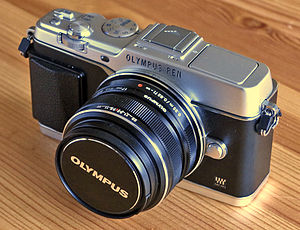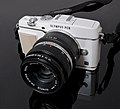Olympus PEN E-P5
 | |
| Overview | |
|---|---|
| Maker | Olympus Corporation |
| Type | Mirrorless interchangeable-lens camera |
| Released | October 2013 |
| Lens | |
| Lens | Interchangeable |
| Sensor/medium | |
| Sensor type | Live MOS |
| Sensor size | Four Thirds (13x17.3mm) |
| Recording medium | SD card |
| Focusing | |
| Focus | Supports autofocus lenses |
| Exposure/metering | |
| Exposure metering | TTL |
| Flash | |
| Flash | Built-In+supports external flashes through the hot shoe |
| Shutter | |
| Frame rate | 9 fps |
| Viewfinder | |
| Viewfinder | Optional external OVF or EVF |
| General | |
| LCD screen | 3" 1.03m pixel resolution |
| Weight | 420g |
| Chronology | |
| Predecessor | Olympus PEN E-P3 |
The Olympus PEN E-P5 is a mirrorless interchangeable-lens camera in the micro four thirds system released in October 2013. This is, despite its number, the fourth model in the PEN E-P range. It remained the latest model in the E-P series until the introduction of the E-P7 in the summer of 2021. It includes the same 16 MP sensor as the Olympus OM-D E-M5. The E-P5 comes in three colour schemes; black, silver and white.[1]
Specifications:
- 16MP Four Thirds sized (13x17.3mm) Live MOS sensor
- 1/8000s top shutter speed
- 5-axis image stabilization with panning detection
- ISO 100 – 25,600
- Burst rate: up to 9 frames per second (5 with continuous auto focus)
- Focus-peaking to assist manual focus
- Intervalometer and Time Lapse movie creation (up to 99 frames)
- 3" LCD touchscreen
- Built-in Wi-Fi for remote shooting (full control of all settings), image transfer and adding geolocation through smartphone
Compared to its predecessor Olympus PEN E-P3
- improved 5-axis sensor stabilization vs 2-axis sensor stabilization
- enhanced in-camera RAW conversion
- HDR bracketing
- fastest shutter speed 1/8000s vs 1/4000s - 1 EV faster
- Wi-Fi connectivity
- 9 fps burst rate vs 3 fps
- new 16 MPx sensor from the E-M5 vs 12 MPx
- higher maximum ISO: 25,600 vs 12,800
- tilting LCD screen vs fixed LCD screen
- Ergonomics: The thumb roller and the adjusting wheel around the d-pad have been replaced with customizable top dials.
Compared to the Olympus OM-D E-M5
In 2012, Olympus started the OM-D series with the E-M5 as their more professional line compared to their PEN series, which had been running for a few years. Back in the day, the main criticism for the PEN series was the lack of built-in viewfinder, the lack of weather-sealing and the weird ergonomics for some. Olympus worked on fixing these when they made the E-M5, and some of its features slid down into the E-P5.
- The E-P5 got the new 16 MPx sensor from the E-M5. Previously, every Olympus Micro Four Thirds camera had a 12 MPx sensor.
- The E-P5 got the 5-axis sensor stabilization with 4 EV efficiency.
- The same 9 fps burst. The low burst rate was a common weakness of previous Micro Four Thirds cameras.
- Tilting rear LCD screen.
There were features where the E-P5 was even better than the E-M5:
- It had 1/8000s fastest shutter speed instead of 1/4000s.
- It had a lot higher resolution back LCD screen: 1.03 million pixels vs 610k
- It had built-in Wi-Fi capabilities.
- It had a built-in flash.
However, the E-M5 had a major feature, the built-in electronic viewfinder, which the PEN series lacked until the PEN F's digital version, which was released in 2016. The EVF became a mainstream feature in the lower categories of mirrorless cameras as well, so the PEN series went to a decline, and a new camera in the main PEN series was not seen again until the E-P7 in 2021.
-
 The tilting LCD screen of the Olympus E-P5
The tilting LCD screen of the Olympus E-P5 -
 The white version
The white version - The E-P5's predecessor, the E-P3
-
 The E-P5 got its 16 MPx sensor from the E-M5
The E-P5 got its 16 MPx sensor from the E-M5 -
 The Olympus E-PL6 was the cheaper alternative to the E-P5
The Olympus E-PL6 was the cheaper alternative to the E-P5
References

- ^ Butler, Richard; Andy Westlake (2013). "Olympus PEN E-P5 Review". DPReview. Retrieved 5 May 2014.
- v
- t
- e
| Brand | Form | Class | 2008 | 2009 | 2010 | 2011 | 2012 | 2013 | 2014 | 2015 | 2016 | 2017 | 2018 | 2019 | 2020 | 2021 | 2022 | 2023 | 2024 | |||||||||||||||||||||||||||||||||||||||||||||||||||
| Olympus | SLR style OM-D | Professional | E-M1X R | |||||||||||||||||||||||||||||||||||||||||||||||||||||||||||||||||||
| High-end | E-M1 | E-M1 II R | E-M1 III R | |||||||||||||||||||||||||||||||||||||||||||||||||||||||||||||||||||
| Advanced | E-M5 | E-M5 II R | E-M5 III R | |||||||||||||||||||||||||||||||||||||||||||||||||||||||||||||||||||
| Mid-range | E-M10 | E-M10 II | E-M10 III | E-M10 IV | ||||||||||||||||||||||||||||||||||||||||||||||||||||||||||||||||||
| Rangefinder style PEN | Mid-range | E-P1 | E-P2 | E-P3 | E-P5 | PEN-F R | ||||||||||||||||||||||||||||||||||||||||||||||||||||||||||||||||
| Upper-entry | E-PL1 | E-PL2 | E-PL3 | E-PL5 | E-PL6 | E-PL7 | E-PL8 | E-PL9 | E-PL10 | |||||||||||||||||||||||||||||||||||||||||||||||||||||||||||||
| Entry-level | E-PM1 | E-PM2 | ||||||||||||||||||||||||||||||||||||||||||||||||||||||||||||||||||||
| remote | Air | |||||||||||||||||||||||||||||||||||||||||||||||||||||||||||||||||||||
| OM System | SLR style | Professional | OM-1 R | OM-1 II R | ||||||||||||||||||||||||||||||||||||||||||||||||||||||||||||||||||
| High-end | OM-5 R | |||||||||||||||||||||||||||||||||||||||||||||||||||||||||||||||||||||
| PEN | Mid-range | E-P7 | ||||||||||||||||||||||||||||||||||||||||||||||||||||||||||||||||||||
| Panasonic | SLR style | High-end Video | GH5S | GH6 R | GH7 R | |||||||||||||||||||||||||||||||||||||||||||||||||||||||||||||||||
| High-end Photo | G9 R | G9 II R | ||||||||||||||||||||||||||||||||||||||||||||||||||||||||||||||||||||
| High-end | GH1 | GH2 | GH3 | GH4 | GH5 | GH5II | ||||||||||||||||||||||||||||||||||||||||||||||||||||||||||||||||
| Mid-range | G1 | G2 | G3 | G5 | G6 | G7 | G80/G85 | G90/G95 | ||||||||||||||||||||||||||||||||||||||||||||||||||||||||||||||
| Entry-level | G10 | G100 | ||||||||||||||||||||||||||||||||||||||||||||||||||||||||||||||||||||
| Rangefinder style | Advanced | GX1 | GX7 | GX8 | GX9 | |||||||||||||||||||||||||||||||||||||||||||||||||||||||||||||||||
| Mid-range | GM1 | GM5 | GX80/GX85 | |||||||||||||||||||||||||||||||||||||||||||||||||||||||||||||||||||
| Entry-level | GF1 | GF2 | GF3 | GF5 | GF6 | GF7 | GF8 | GX800/GX850/GF9 | GF10/GF90 | |||||||||||||||||||||||||||||||||||||||||||||||||||||||||||||
| Camcorder | Professional | AG-AF104 | ||||||||||||||||||||||||||||||||||||||||||||||||||||||||||||||||||||
| Kodak | Rangefinder style | Entry-level | S-1 | |||||||||||||||||||||||||||||||||||||||||||||||||||||||||||||||||||
| DJI | Drone | . | Zenmuse X5S | |||||||||||||||||||||||||||||||||||||||||||||||||||||||||||||||||||
| . | Zenmuse X5 | |||||||||||||||||||||||||||||||||||||||||||||||||||||||||||||||||||||
| YI | Rangefinder style | Entry-level | M1 | |||||||||||||||||||||||||||||||||||||||||||||||||||||||||||||||||||
| Yongnuo | Rangefinder style | Android camera | YN450M | YN455 | ||||||||||||||||||||||||||||||||||||||||||||||||||||||||||||||||||
| Blackmagic Design | Rangefinder style | High-End Video | Cinema Camera | |||||||||||||||||||||||||||||||||||||||||||||||||||||||||||||||||||
| Pocket Cinema Camera | Pocket Cinema Camera 4K | |||||||||||||||||||||||||||||||||||||||||||||||||||||||||||||||||||||
| Micro Cinema Camera | Micro Studio Camera 4K G2 | |||||||||||||||||||||||||||||||||||||||||||||||||||||||||||||||||||||
| Z CAM | Cinema | Advanced | E1 | E2 | ||||||||||||||||||||||||||||||||||||||||||||||||||||||||||||||||||
| Mid-Range | E2-M4 | |||||||||||||||||||||||||||||||||||||||||||||||||||||||||||||||||||||
| Entry-Level | E2C | |||||||||||||||||||||||||||||||||||||||||||||||||||||||||||||||||||||
| JVC | Camcorder | Professional | GY-LS300 | |||||||||||||||||||||||||||||||||||||||||||||||||||||||||||||||||||
| SVS-Vistek | Industrial | EVO Tracer | ||||||||||||||||||||||||||||||||||||||||||||||||||||||||||||||||||||
No Video | Weather Sealed | All the Rest

















